Unlocking Your Potential: A Comprehensive Guide to Zone Training for Swimmers
 Karen Parnell
March 01, 2023
Karen Parnell
March 01, 2023
Understanding Zone Training for Swimming
Swimming, running, and cycling are the three disciplines you will need to train for to be able to race your triathlon, but each requires a different level of intensity and effort. This is why it's important to understand the unique heart rate zones for each of these activities and how they differ from one another.
Here we will look at the swimming training zones including Critical Swim Speed (CSS), T-Pace, Lactate Threshold and VO2 max as well as Rate of Perceived Exertion (RPE).
But first we will compare heart rate zones for swimming, cycling, and running and why they differ.
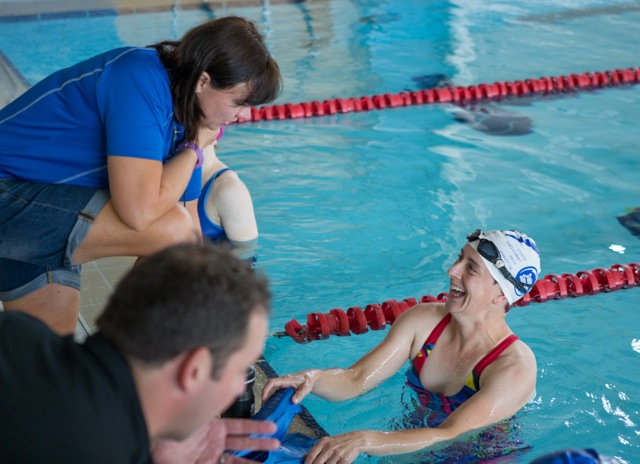
Swim Coaching and Testing with Coach Karen at Chilitri
Get your FREE swimming workouts and tips book here.
Get your FREE Swim Workouts for Triathletes E-book
Heart Rate Zones for Swimming, Cycling and Running
Heart rate zones are calculated based on your maximum heart rate, which is the highest number of beats your heart can make in a minute. The five main heart rate zones are:
- Z1: Resting/Recovery (50-60% of your max heart rate)
- Z2: Base or Easy (60-70% of your max heart rate)
- Z3: Moderate or Tempo (70-80% of your max heart rate)
- Z4: Threshold (80-90% of your max heart rate)
- Z5: Max Effort or Anaerobic (90-100% of your max heart rate)
While these percentages will remain the same across each discipline, your heart rate will vary between each. A common way to establish heart rate zones is to simply subtract your age from 220—however this is not individualized and can be highly inaccurate. To establish your specific heart rate training zones, you will want to do tests in each of the three disciplines to see where your lactate threshold is. It’s important to test in each discipline as they will be different and once you have your specific zones should be entered into TrainingPeaks, FinalSurge or whatever software you use to track your training.
A 2009 study in the Journal of Strength and Conditioning Research backs this up, noting that—at least for cycling and running—athletes should be doing sport-specific testing to establish training zones.
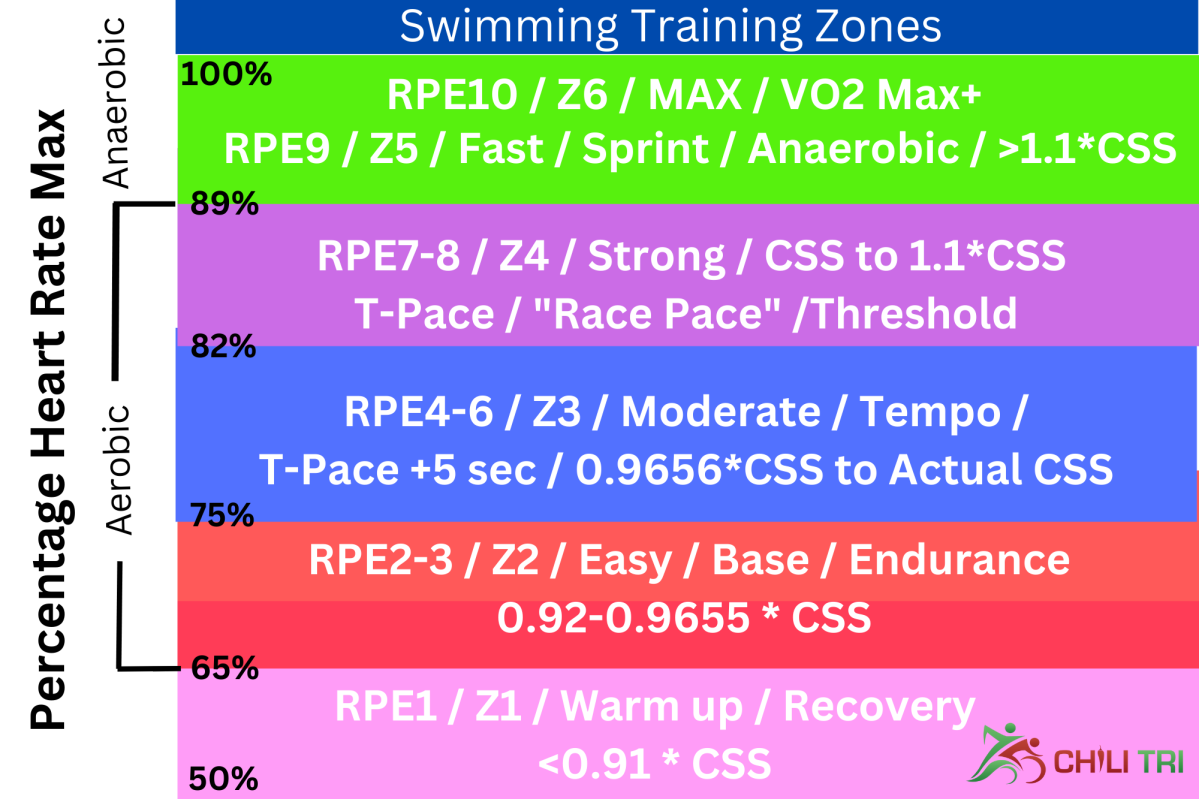
Swimming Heart Rate Zones
Swimming is a low-impact, full-body workout that provides numerous benefits, including improved cardiovascular health, increased strength, and improved flexibility. However, the heart rate zones for swimming are different from those for running and cycling.
Swimming, a horizontal, non-weight bearing activity, will, on average, have the lowest heart rate maximum of the three disciplines in triathlon.
Even though the resistance of water is 800 times more than air you will find it had to get your heart rate up. Also, water does not conduct wireless data like that over ANT+ or Bluetooth very well so your chest strap heart rate monitor (HRM) and even your heart rate monitor on your watch can be impacted by water. I have found using the Polar Verity Sense HRM clipped on to my goggle strap to be the most effective way to capture heart rate as a swim.
Usually, a chest located HR transmitter will always report more accurate data than a wrist transmitter - electrocardiography being more accurate than optical sensors but in the case of swimming an optical sensor located on your temple above water will make more accurate readings.
For swimming, a common test is to do a 400m/yard and 200m/yard time trial and take your pace and heart rate from that effort to establish your threshold or Critical Swim Speed (CSS) and then extrapolate the percentages of each heart rate zone from there. You can find out more details about how to complete the CSS test here.
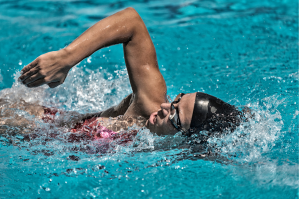
Get your FREE Swim Workouts for Triathletes E-book
Cycling Heart Rate Zones
Cycling, as a partial weight bearing activity with five shared points of weight bearing—hands, seat, feet) normally, will have the second lowest heart rate out of swimming, cycling, and running.
Cycling is a low-impact exercise that provides a full-body workout and numerous health benefits, including improved cardiovascular health, increased endurance, and improved flexibility.
For cycling, a FTP (functional threshold power) test is common. A simple FTP test is to warm-up well, do 5 minutes hard, recover, then do a 20-minute all-out effort to determine your heart rate across those 20 minutes. You can find out more about how to conduct and FTP test here.
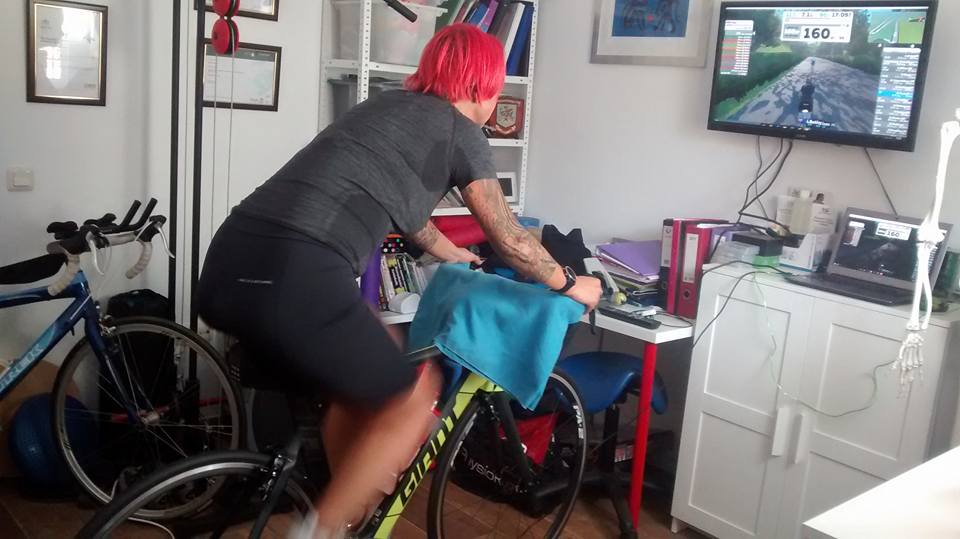
FTP Testing at ChiliTri in Spain
Get your FREE 31 Structured Training Sessions HERE.
Running Heart Rate Zones
Running is a high-impact exercise that places a significant amount of stress on the heart, lungs, and legs. This is why the heart rate zones for running are typically higher than those for swimming and cycling. Running is an excellent form of cardiovascular exercise, as it helps to improve heart and lung function, increase endurance, and burn calories.
For running, a similar test to cycling is often used—with a 30-minute all-out effort where you look at your heart rate across the last 20 minutes to establish a threshold. For more benchmark tests to help you establish training zones, check out the Cooper Test. You should also re-test every few months to ensure your zones haven’t changed.
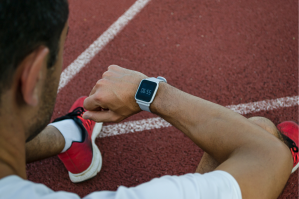
Cooper Run Test at a 400m Track
Get your FREE Guide to Running Speed and Technique
Alternatives to Heart Rate in Swimming
Of course, using heart rate zones are just one piece of the total training puzzle. This is, in part, because your heart rate can not only vary by discipline, but also from day-to-day. According to the American Heart Association, there are several factors that influence your heart rate, including stress, caffeine, altitude, sleep, and even the weather (at higher temperatures, your heart pumps more blood).
Rate of Perceived Exertion (RPE) for Swimming
Heart rate isn’t static, and it changes with emotions, weather, quality of sleep, and what we’ve had to eat or drink. This is one of the reasons why it’s important to train with heart rate as well as perceived effort and power.
That’s why being able to correlate your heart rate with a Rate of Perceived Exertion (RPE) is important, especially if your heart-rate monitor of choice malfunctions and you can’t get a measurement. If you’ve done enough training at set effort levels, then you’ll learn what they feel like. Over time you will develop an “internalized heart rate and effort clock” to seamlessly equate those heart rate zones into your training and racing by feel. It’s important for athletes not to become so dependent upon monitored heart rate you lose their ‘feel’ for racing. I can remember my coach asking me not to race with a heart rate monitor as he said that on race day nerves would have an impact and my heart rate could be higher. If I raced to heart rate, I may not race as hard as I could on the day, and he encouraged me to “race to feel” – so race to RPE.
Understanding Critical Swim Speed (CSS)
CSS is Critical Swim Speed and is a term now commonly used when swim training and can be found by completing a time trial swim of 400m and 200m and then entering your times into a CSS calculator. You can use the ChiliTri on here:
https://chilitri.com/calculators
Click on the “swimming” tab. You can find out more about CSS and how to complete a swimming time trial here.
It is most used in conjunction with a Finis Tempo Trainer Pro where the Tempo Trainer is set relative to your CSS stats to enable you to train at the right effort level. You can read more about CSS and the Tempo Trainer Pro swim training here.
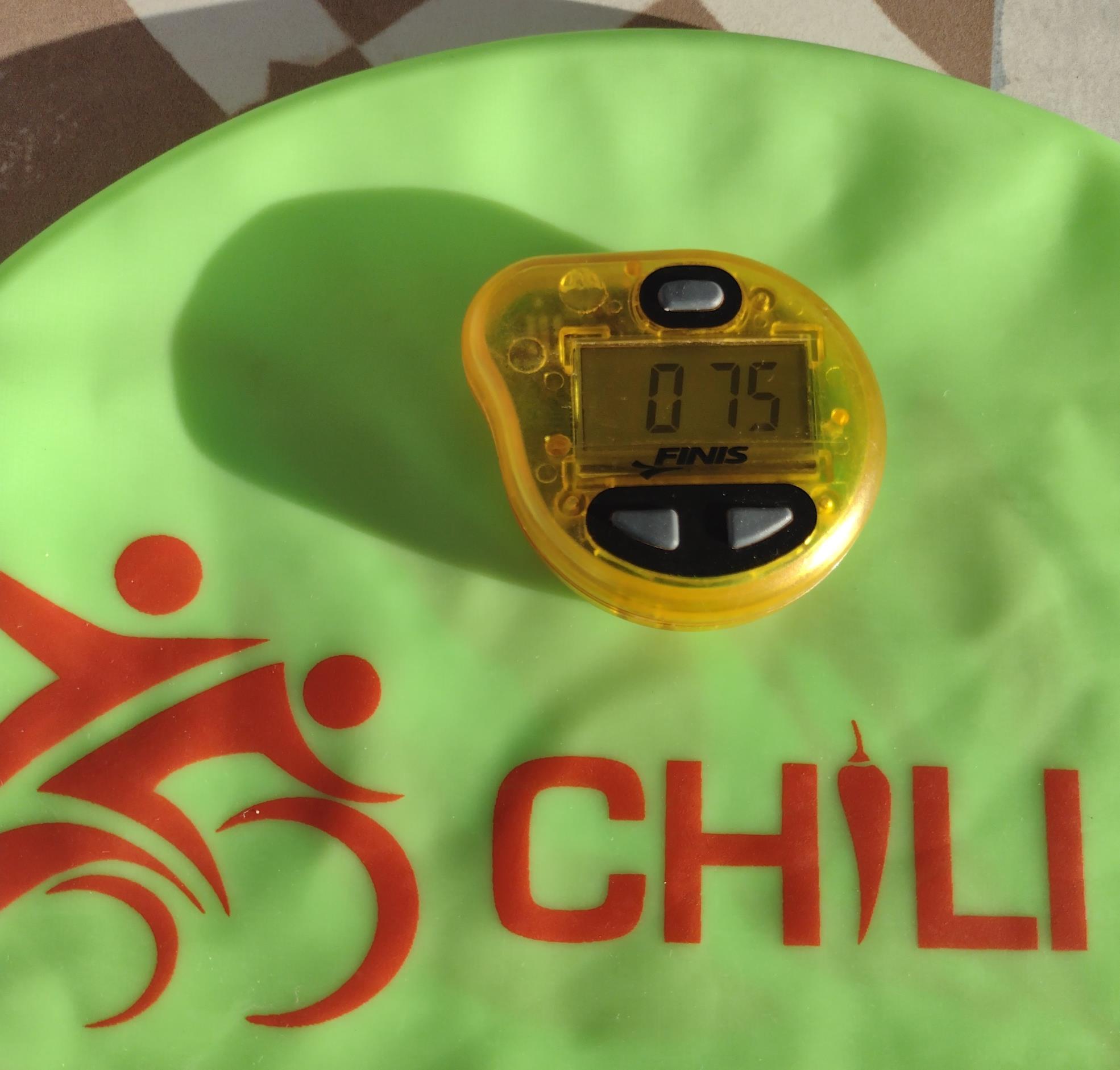
Finis Tempo Trainer useful for CSS Training at ChiliTri
Get your FREE swimming workouts and tips book here.
What is T-Pace?
T-Pace or Threshold pace is another commonly used term when it comes to swim training and is determined by a time trial to determine your current threshold pace. Think of T-Pace as the swimming equivalent of an LTHR test in running, or an FTP test in cycling, except, instead of being based on heart rate or power, it's based on swim pace.
Once you determine your current T-Pace, you will base all your zones on it. For example, Zone 1 will be several seconds slower than your T-Pace, Zone 5 will be several seconds faster than it.
How to test your T-Pace
Depending on how advanced of a swimmer you are, there are three different tests you can execute. Please note that the distances are interchangeable between meters and yards.
Each of the three following tests have a 10 minute (or longer) warm up, followed by a 2-minute rest. The main sets should be swum as fast as possible while maintaining a consistent pace. If you record the test with a swimming watch, start a new workout at the beginning of the main section, and pause during rests. If you don't have a watch, note the exact times that you start and stop, or, use a stopwatch.
1000 Meter T-Pace Test
Strong swimmers should take this test. It's the most common T-Pace test, and generally considered the most accurate:
- Warm up
- Rest for 2 minutes
- Swim 1000 meters without resting at a consistent pace
- Warm down
The total amount of time that it took you to complete the 1000 meters is central to this test. To determine your T-Pace, take the time it took you to swim 1000 meters, and divide it by 10. The result is your T-Pace. That sounds easy, but you need to adjust the equation to compensate for the mechanics of time (60 seconds = 1 minute, etc.).
For mid-level swimmers there is the 3 x 300 test and novice swimmers the 3 x 100 test.
How to adjust swim zones based on your T-Pace
When you've completed one of the above tests and determined your current T-Pace, you should adjust your swimming pace zones accordingly. Because zones are ranges, you will be positioning your T-Pace time in the middle of Zone 4.
This is how to adjust your swimming pace zones:

For example, if your T-Pace was 2:00, you would adjust your Zone 4 range to be 1:58 to 2:02, a 5-second range with 2:00 in the middle. Then you would adjust Zone 3 to be 2:02 to 2:07, a range 5 seconds slower than Zone 4. Next, you would adjust Zone 2 to be 2:07 to 2:17, a range 10 seconds slower than Zone 3. Zone 1 would be 2:17 to >, and Zone 5 would be 1:58 to T-pace.
Understanding VO2Max
VO₂ max is the maximum rate of oxygen consumption attainable during physical exertion. The name is derived from three abbreviations: "V̇" for volume, "O₂" for oxygen, and "max" for maximum.
VO₂ max refers to how much oxygen your body can absorb and use during swimming.
Oxygen is a critical ingredient in the respiratory process that’s involved in breathing. As you breathe in oxygen, your lungs absorb and turn it into energy called
ATP powers your cells and helps release the carbon dioxide (CO₂) that’s created during your respiratory process when you exhale.
The benefits are simple: The greater your VO₂ max, the more oxygen your body can consume, and the more effectively your body can use that oxygen to generate the maximum amount of ATP energy.
This means that your body can better handle aerobic fitness activities that require a lot of oxygen intake like running, swimming, and other types of cardio.
A high VO₂ max can be a good predictor of your athletic performance, especially if you’re a runner or a swimmer. Your VO₂ max amount can also act as a benchmark to track your progress as you improve your athletic abilities or if you’re trying to keep your VO₂ max at a certain level to maintain your performance.
But while oxygen uptake is more frequently used for athletes, is not just for athletes. It is a way to determine cardiorespiratory fitness in anyone. Medical professionals can use it to determine your heart and lung health.
Everyone — no matter their athletic ability — should try to increase their cardiorespiratory endurance. According to research, a higher VO₂ max is associated with longevity.
Typically, VO₂ max tests are conducted in a medical facility like a lab or hospital by a doctor, cardiologist, or fitness specialist.
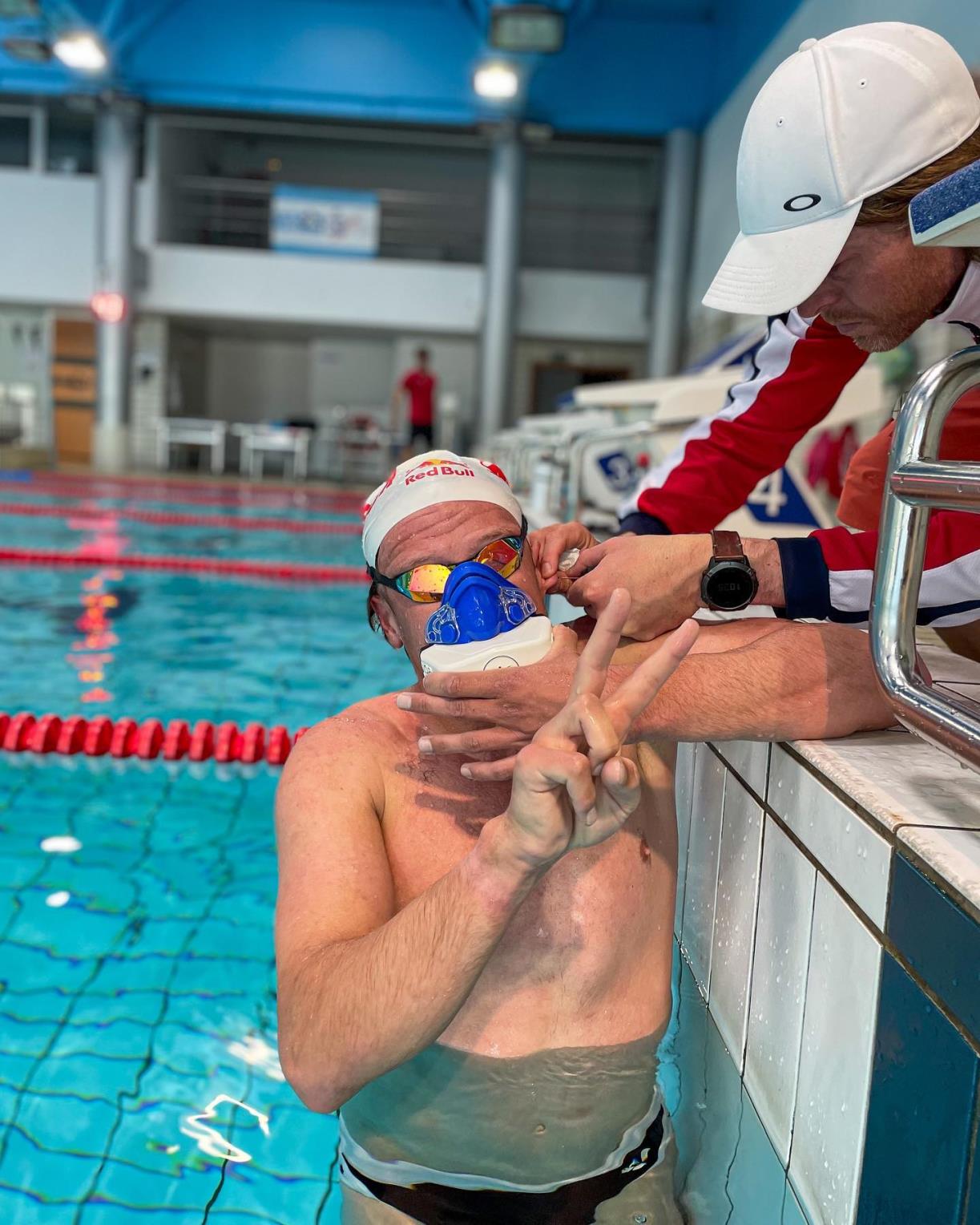
VO2max swim testing in Sierra Nevada High Altitude Centre in Spain
Get your FREE Open Water Swimming Sessions E-Book
Submaximal Exercise Tests
Some personal trainers and fitness instructors may also have certifications that allow them to conduct VO₂ max tests. These tests may be called “
Submaximal exercise tests are still a useful way to measure your VO₂ max levels and your overall levels of heart and lung endurance during exercise.
The type of VO₂ max test that’s best for you depends on your fitness level. Your doctor or instructor may have you do one of the following tests if you exercise regularly or are a trained athlete:
Astrand treadmill test - 2.4 km run test
- multistage bleep test
You may do a simple walk/run test on a treadmill if you’re newer to exercise or have not exercised for some time. Other possible VO₂ max tests include:
Cooper 1.5-mile walk-run test - Rockport 1-mile walk test
treadmill test - · compare your best speed or time to average results from others for similar activities
Doing a VO2max test on swimmers on a treadmill or bicycle is not a valid alternative as running and cycling use different muscle groups and actions. So how do we complete a VO2max test on swimmers?
VO2max and Lactate Threshold Testing for Swimmers
Completing a VO2max can be difficult but not impossible and most swimmers use CSS and swimming time trials to understand if their swim training is having the desired effect. But if you are interested here is what’s needed for a more scientific test.
Swimming Ergometers
There are several possible swimming ergometer methods that can be used. A swim flume is a small swimming pool in which water flows past the swimmer who can remain stationary. This could be an Endless Pool like the one we have at ChiliTri. A pool tether has a similar effect, as the swimmer is tied to the side of the pool and swims against the pull of the tether. A swim bench is the out of water alternative. The subject lies on a horizontal bench, with the arms and legs attached to weighted pulleys or adjustable elastic cords.
Gas Analysis Equipment
Oxygen consumption measuring equipment (e.g., oxygen and carbon dioxide analysers, or expired air may be collected, and volume measured via Douglas bags or a Tissot tank or measured by a pneumotach or turbine ventilometer). Most VO2max assessment equipment is bulky and not very portable. If they are portable, they may not be waterproof. Some systems have been set up to be moved along the side of the pool while a snorkel is attached to the swimmers.
Other Equipment Required
Swimming pool, a waterproof stopwatch, waterproof heart rate monitor, blood lactate measurement device, metronome, and RPE scale (optional).

Get your FREE Open Water Swimming Sessions E-Book
Pre-Test
The test procedures will be explained to you before your swim. You will have a health screening and sign a consent form. The record forms will be prepared, and the testers will record basic information such as your age, height, body weight, gender, test conditions. They will then heck and calibrate the equipment. You will then perform an appropriate warm-up.
Test Procedure
Exercise is performed in the water, using one of the swimming ergometer methods. The exercise workloads are selected to gradually progress in increments from moderate to maximal intensity. In the pool an incremental protocol such as the 7x200m can be used. Any stroke can be performed. A metronome can be used to set the stroke frequency as a method of increasing workload.
Measurement
Oxygen uptake is calculated from measures of ventilation and the oxygen and carbon dioxide in the expired air, and the maximal level is determined at or near test completion. Heart rate should be measured every minute of the test, and you may also want to measure ratings of perceived exertion (RPE).
You can also do the test by analysing blood lactate by taking a small amount of blood from the swimmer, usually from the ear lobe, and testing it in a handheld blood lactate tester. Lactate measurements are traditionally used for exploration of endurance capacity and for attempts to locate Anaerobic Threshold (AT). So, it is not a coincidence that other names for AT relate to lactate. Lactate Threshold, Lactate Turn Point, Maximal Lactate Steady State, Minimum Lactate Equivalent, Onset of Blood Lactate Accumulation etc. VO2 max is an athlete's ability to maximally consume oxygen while lactate threshold is a determination of the point at which lactate cannot be cleared as fast as it is accumulated. Although different, lactate threshold occurs at a percentage of VO2 so the two are related measurements.
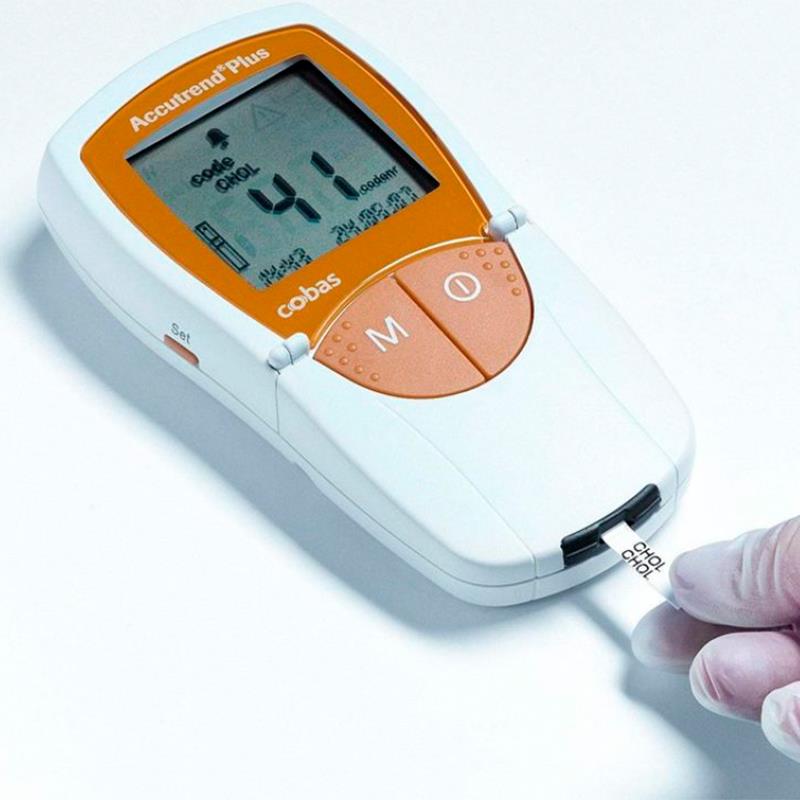
Get your FREE 23-Page Athletes Guide to Strength and Conditioning
A higher lactate threshold is a much better indicator of overall athletic performance compared to VO2 max because it provides insight on how the muscles are utilizing available oxygen. It may also be more convenient than wearing a mask when swimming and just collecting small amounts of blood throughout the swimming test.
Lactate threshold is defined as the point during high intensity exercise where the liver can no longer clear lactate faster than it is being accumulated in the blood. Lactate or lactic acid is a by-product of anaerobic metabolism and is responsible for the burning sensation that athletes may feel when they are working at high efforts. Lactate threshold occurs at a percentage of an athletes VO2 max based on their training status. It will occur in untrained individuals at about 50-60% of VO2 max and about 70-80% of VO2 max in trained individuals. Contrary to popular belief, lactate is not responsible for fatigue in the muscle and can be used as an energy source in certain types of muscle tissue like cardiac muscle tissue.
Scoring
Results are presented as either l/min (liters per minute) or ml/kg/min (mls of oxygen per kilogram of body weight per minute). The swimmer is considered to have reached their VO2max if several of the following occurred: a plateau or 'peaking over' in oxygen uptake, maximal heart rate was reached, attainment of a respiratory exchange ratio of 1.15 or greater, and volitional exhaustion.
Target Population
The swimming VO2max test is appropriate only for experienced swimmers. It is a maximal exercise test, which requires a reasonable level of fitness. It is not recommended for recreational athletes or people with health problems, injuries, or low fitness levels.
Advantages
For swimmers, this is the most specific aerobic test they can do.
Disadvantages
The equipment required to perform a swimming VO2max test is expensive, and the test is time consuming and complex to conduct. With the attachment of extra equipment, the swimmer may not be able to perform their natural stroke.
Understanding VO2max and Lactate Threshold
The best way to look at the two values in my opinion is to think of VO2 max as a bucket and lactate threshold as water in the bucket. Training to improve VO2 max increases the size of the bucket and training to improve lactate threshold increases the water in the bucket. If you’re thirsty, you want a big bucket to allow you to drink the most water, but you need to fill that bucket with as much water as possible to quench your thirst! If you have a High VO2 max that’s great, but if you can only work at 50-60% of it then it doesn’t do you much good!
Swimming Training Zones
We have seen that there are many ways to test your performance and put a steak in the ground for your current fitness levels. The chances are you will need to do some sort of time trail to set your benchmarks and use heart rate of RPE during your training to ensure you are training at the right level.
I have put together this chart to show how each commonly used training zone term interrelates so whatever training plan or method you use you can see how they stack up. This is not perfect but should be to use to help you decypher your training sessions and help to train in the rigtht zones to help you solicit the right physical adaptations and not train too hard to too easy.
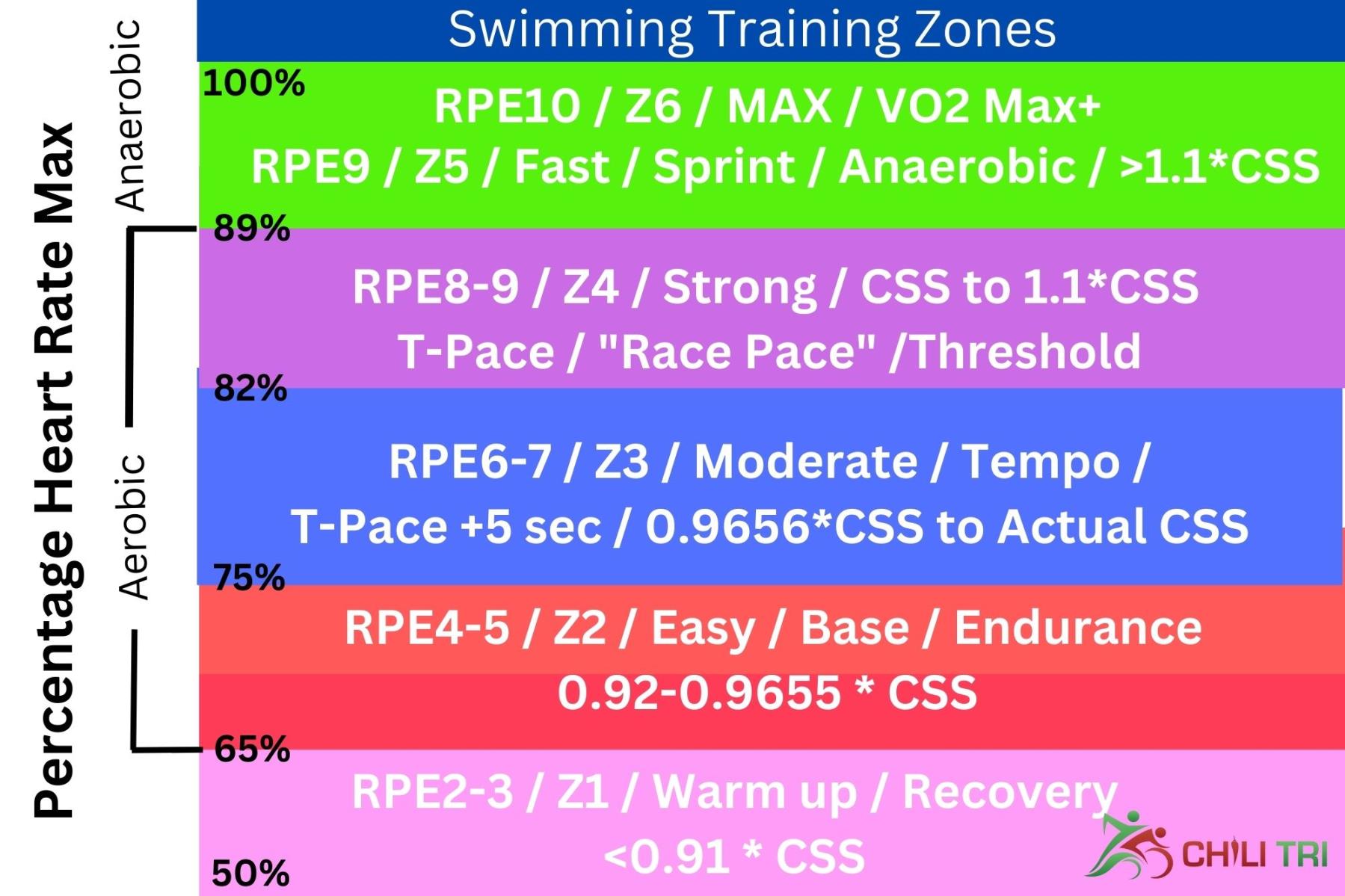
Swimming Training Zones Chart, Heart Rate, RPE & CSS from ChiliTri
Get your FREE swimming workouts and tips book here.
Conclusion: Swimming Training Zones
Understanding the intricacies of zone training is essential for swimmers aiming to unlock their full potential.
By grasping concepts like Critical Swim Speed, T-Pace, Lactate Threshold, and VO2 max, you can tailor your training regime to meet specific goals and improve your performance in the water.
Additionally, recognizing the differences in heart rate zones across swimming, cycling, and running will empower you to optimize your training strategy effectively.
As you integrate these insights into your workouts, you’ll find yourself not just swimming faster, but training smarter, paving the way for greater success in your triathlon journey.
Karen Parnell is a Level 3 British Triathlon and IRONMAN Certified Coach, 8020 Endurance Certified Coach, WOWSA Level 3 open water swimming coach and NASM Personal Trainer and Sports Technology Writer.
Karen has recently completed a postgraduate MSc in Sports Performance Coaching at the University of Stirling.
Need a training plan? I have plans on TrainingPeaks and FinalSurge:
I also coach a very small number of athletes one to one for all triathlon and multi-sport distances, open water swimming events and running races, email me for details and availability. Karen.parnell@chilitri.com
Get your FREE Guide to Running Speed and Technique
Get your FREE Swim Workouts for Triathletes E-book
Get your FREE Open Water Swimming Sessions E-Book
FAQ: Swimming Training Zones
What are swimming heart rate zones?
Swimming heart rate zones are a way to measure the intensity of your swim workout based on your heart rate. These zones are typically divided into five or six levels, with each level corresponding to a range of heartbeats per minute (bpm). By training in specific heart rate zones, you can target different physiological systems and improve your swimming performance.
What is RPE?
RPE, or rating of perceived exertion, is a subjective measure of how hard you feel like you're working during a swim workout. The scale typically ranges from 1 to 10, with 1 being very easy and 10 being maximal effort. RPE can be a useful tool to help you stay within your desired training zones, especially if you don't have access to heart rate monitoring equipment.
What is CSS?
CSS, or critical swim speed, is the pace you can sustain for a continuous swim of 1500 meters. CSS is often used as a benchmark in swimming training and can help you determine your optimal training paces for different types of workouts.
What is VO2max?
VO2max is a measure of your body's maximum oxygen uptake capacity, or how efficiently your muscles can use oxygen during exercise. VO2max is often used as an indicator of cardiovascular fitness and can be improved through regular aerobic exercise.
What is T-pace?
A: T-pace, or threshold pace, is the pace you can sustain for a continuous swim of 30-60 minutes. T-pace is often used as a training benchmark for endurance swimmers and can be a useful tool for setting training goals and tracking progress.
What is threshold?
In swimming, threshold refers to the point at which your body switches from aerobic metabolism to anaerobic metabolism, meaning you start producing more lactic acid. This point can be measured by your heart rate, lactate threshold, or T-pace, and can be a useful tool for setting training goals and monitoring progress.
What is sports lactate testing?
Sports lactate testing is a method of measuring the concentration of lactate in the blood during exercise. The test involves taking multiple blood samples at specific intervals during a graded exercise test, usually on a treadmill or stationary bike. The results of the test can help athletes and coaches determine optimal training zones, set training goals, and monitor progress over time.
Why is lactate testing important for athletes?
Lactate testing can provide valuable information about an athlete's physiological response to exercise. By measuring the lactate threshold, or the point at which lactate levels start to increase rapidly, athletes and coaches can determine the optimal training zones for different types of workouts. Lactate testing can also help athletes identify areas of weakness and track improvements over time.
How is sports lactate testing performed?
Sports lactate testing typically involves a graded exercise test, where the athlete exercises at progressively increasing intensities while blood samples are taken at specific intervals. The test can be performed on a treadmill, stationary bike, or other exercise equipment. The lactate concentration in the blood is measured using a small sample of blood taken from a finger or earlobe.
What are the benefits of sports lactate testing?
Sports lactate testing can provide athletes and coaches with valuable information about an athlete's physiological response to exercise, including their lactate threshold, maximal lactate steady state, and VO2max. This information can be used to set optimal training zones, monitor progress over time, and identify areas of weakness that need to be addressed in training.
Who can benefit from sports lactate testing?
Sports lactate testing can be useful for athletes of all levels, from recreational athletes to elite competitors. The test can be especially helpful for endurance athletes such as runners, cyclists, and triathletes, as well as team sport athletes who require a high level of aerobic fitness.
Are there any risks or side effects of sports lactate testing?
Sports lactate testing is generally considered safe and non-invasive, with minimal risks or side effects. The most common side effect is mild discomfort or pain when the blood sample is taken. However, athletes with certain medical conditions, such as diabetes or blood clotting disorders, should consult with their doctor before undergoing the test.
What is VO2max testing?
VO2max testing is a method of measuring an individual's maximum oxygen uptake during exercise. It is typically performed on a treadmill or stationary bike and involves breathing into a mask or mouthpiece that measures the amount of oxygen consumed and carbon dioxide produced during exercise. The results of the test can provide valuable information about an individual's cardiovascular fitness and aerobic capacity.
Why is VO2max testing important for athletes?
VO2max testing can provide valuable information about an athlete's cardiovascular fitness and aerobic capacity, which can be used to optimize training programs and monitor progress over time. Athletes with a high VO2max are often able to perform at a higher level for longer periods of time, making the test particularly important for endurance athletes such as runners, cyclists, and triathletes.
How is VO2max testing performed?
VO2max testing typically involves a graded exercise test, where the individual exercises at progressively increasing intensities while their oxygen consumption and carbon dioxide production are measured. The test is often performed on a treadmill or stationary bike, and the individual wears a mask or mouthpiece to measure their breathing. The test can be performed in a laboratory or field setting, depending on the equipment and resources available.
What are the benefits of VO2max testing?
VO2max testing can provide valuable information about an individual's cardiovascular fitness and aerobic capacity, which can be used to optimize training programs and monitor progress over time. The test can help athletes and coaches identify areas of weakness and target specific training zones to improve performance. Additionally, VO2max testing can be used to establish baseline data and track changes in fitness over time.
Who can benefit from VO2max testing?
VO2max testing can be useful for athletes of all levels, from recreational athletes to elite competitors. The test can be especially helpful for endurance athletes such as runners, cyclists, and triathletes, as well as team sport athletes who require a high level of aerobic fitness.
Are there any risks or side effects of VO2max testing?
VO2max testing is generally considered safe and non-invasive, with minimal risks or side effects. The most common side effect is mild discomfort or fatigue during the test. However, individuals with certain medical conditions, such as heart disease or asthma, should consult with their doctor before undergoing the test. Additionally, the test can be physically demanding, and individuals should be adequately prepared before attempting the test.
References
Transferability of running and cycling training zones in triathletes: implications for steady-state exercise Daniel g. Carey, Courtney Tofte, German j. Pliego, and Robert l. Raymond
All About Heart Rate (Pulse) | American Heart Association
Blood lactate testing in training: Is it worth to bleed? (sportsciencesupport.com)
VO2 Max and Lactate Testing for Runners (runandbecome.com)
Swim VO2 max test (topendsports.com)
VO₂ Max: Definition, How It's Measured, How to Improve (healthline.com)
Swimming : Maximum oxygen consumption (VO2max) (nataswim.info)
How to use swim zones: Determine your current T-Pace and swimming zones | SportTracks
Heart Rate Zones: How To Use This Training Metric – Triathlete
#swimming #swimmer #triathlon #triathlete #ironman #css #hr #heartratezones #trainingzones #vo2 #lactate #threshold #vo2max #traithlontrainingplans #runningtrainingplans #swimmingtrainingplans
This website uses affiliate links which may earn a commission at no additional cost to you. As an Amazon Associate I earn from qualifying purchases. which may cover part of a cup of coffee for me to fuel my training.
